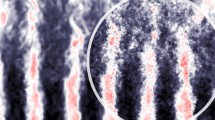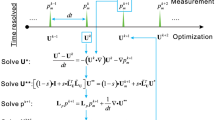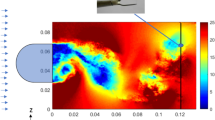Abstract
Particle image velocimetry with local field correction (LFC PIV) has been tested in the past to obtain two components of velocity in a two dimensional domain (2D2C). When compared to conventional correlation based algorithms, this advanced technique has shown improvements in three important aspects: robustness, resolution and ability to cope with large displacements gradients. A further step in the development of PIV algorithms consists in the combination of LFC with the stereo technique, which is able to obtain three components of velocity in a plane (2D3C PIV). In this work this combination is implemented and its performance is evaluated carrying out the following two different tasks:
-
–
Comparison of robustness and accuracy for large and small scale flow structures. This is carried out using three techniques: the conventional Stereo PIV, the Stereo-LFC PIV and the Stereo-Multigrid PIV enhanced with image distortion.
-
–
Insight on the limit of resolvable scales for the Stereo-LFC. This task is relevant because the resolution attainable by this combination is higher than what has been obtained by the rest of the herein used algorithms.
The first task has been achieved using synthetic images. Afterwards the coherence of the results has been checked with real images. The results show improvement of Stereo-LFC PIV in respect to Stereo-Multigrid PIV enhanced with image distortion. The performance of Stereo-LFC when only large scales are involved shows an increase of the dynamic range of measurable vorticity. When small scales are analysed, the magnitude of the error resulting when using Stereo-LFC is about half of the one obtained for the Stereo-Multigrid measurements. Results with errors below 20% have been achieved for some of the cases with peak vorticities as large as 1.8 Δt −1 (in the absence of out-of-plane displacements), out-of-plane loss of particle pairs of 65% (with a low peak vorticity of 0.06 Δt −1) and peak vorticities as large as 1.5 Δt −1 with 50% particle pair loss. For the second task most of the information has been obtained using real images. It has been found that the resolution limit is very dependent on the robustness of the algorithms against image defects and variability. The results show a remarkable improvement when using the Stereo-LFC PIV processing, although a full quantification and characterization would need further study because of the variety of noise sources possible in a real image.












Similar content being viewed by others
References
Astarita T (2007) Analysis of weighting windows for image deformation methods in PIV. Exp Fluids 43(6):859–872
Bridges J (2002) Measurements of turbulent flow field in separate flow nozzles with enhanced mixing devices—test report. NASA/TM-2002-211366
Kean RD, Adrian RJ (1993) Theory of cross-correlation analysis of PIV images. Flow visualization and image analysis. Kluwer Academic Publishers, Dordrecht, pp 1–25
Lecuona A, Nogueira J, Rodríguez PA, Acosta A (2004) PIV evaluation algorithms for industrial applications. Meas Sci Technol 12:1911–1921
Nauri S, Legrand M, Lecuona A, Rodríguez PA, Nogueira J (2006) Combination of advanced 2D PIV and Stereo Technique. In: 13th international symposium on application of laser techniques to fluid mechanics, Lisbon
Nauri S, Nogueira J, Lecuona A, Legrand M, Rodríguez PA (2007) Limits and accuracy of the Stereo-LFC PIV Technique. In: 7th international symposium on particle image velocimetry, Rome
Nogueira J, Lecuona A, Rodríguez PA (2001) Local field correction PIV, implemented by means of simple algorithms, and multigrid versions. Meas Sci Technol 12:1911–1921
Nogueira J, Lecuona A, Ruiz-Rivas U, Rodríguez PA (2002) Analysis and alternatives in two-dimensional Multigrid particle image velocimetry methods: application of a dedicated weighting function and symmetric direct correlation. Meas Sci Technol 13:963–974
Nogueira J, Lecuona A, Rodríguez PA (2005) Limits on the resolution of correlation PIV iterative methods. Fundamentals. Exp Fluids 39(2):305–313
Nogueira J, Legrand M, Nauri S, Rodríguez PA, Lecuona A (2008) Analysis of the vortex street generated at the core bypass lip of a jet engine nozzle. Top Appl Phys 112:419–428
Prasad AK (2000) Stereoscopic particle image velocimetry. Exp Fluids 29:103–116
Prasad AK, Adrian RJ (1993) Stereoscopic particle image applied to liquid flows. Exp Fluids 15:49–60
Prasad AK, Jensen K (1995) Scheimpflug stereocamera for particle image velocimetry to liquid flows. Appl Opt 34:7092–7099
Scarano F (2002) Iterative image deformation methods in PIV. Meas Sci Technol 13:R1–R19
Scarano F (2004) Super-resolution particle image velocimetry interrogation approach by means of velocity second derivatives correlation. Meas Sci Technol 15:475–486
Soloff SM, Adrian RJ, Liu Z-C (1997) Distortion compensation for generalized stereoscopic particle image velocimetry. Meas Sci Technol 8:1441–1454
Westerweel J (1998) Effect of sensor geometry on the performance of PIV. In: 9th international symposium on applications of laser techniques to fluid mechanics. Instituto Superior Técnico, Lisbon
Westerweel J, Nieuwstadt FTM (1991) Performance tests on 3-dimensional velocity measurements with a two-camera digital particle-image velocimeter. Laser anemometry advances and applications, vol. 1. ASME, New York, pp 349–355
Wieneke B (2005) Stereo-PIV using self-calibration on particle images. Exp Fluids 39:267–280
Willert C (1997) Stereoscopic digital particle image velocimetry for applications in wind tunnel flows. Meas Sci Technol 8:1465–1479
Zang W, Prasad AK (1997) Performance evaluation of a Sheimpflug stereocamera for stereoscopic particle image velocimetry. Appl Opt 36:8738–8744
Acknowledgments
This work has been partially funded by the COJEN European project, Specific Targeted RESEARCH Project EU Contract No. AST3-CT-2003-502790; the Spanish Research Agency grants DPI2002-02453 “Técnicas avanzadas de Velocimetría por Imagen de Partículas (PIV) Aplicadas a Flujos de Interés Industrial” and ENE2006-13617 “TermoPIV” and under the EUROPIV 2 European project (CONTRACT No: GRD1-1999-10835) and its associated DPI-2000-1839-CE co-funded by the Spanish Research Agency. The authors would like to thank the technicians Manuel Santos and Carlos Cobos for their assistance in the measuring devices set-up.
Author information
Authors and Affiliations
Corresponding author
Rights and permissions
About this article
Cite this article
Nauri, S., Nogueira, J., Lecuona, A. et al. Limits and accuracy of the Stereo-LFC PIV technique and its application to flows of industrial interest. Exp Fluids 45, 609–621 (2008). https://doi.org/10.1007/s00348-008-0545-x
Received:
Revised:
Accepted:
Published:
Issue Date:
DOI: https://doi.org/10.1007/s00348-008-0545-x




